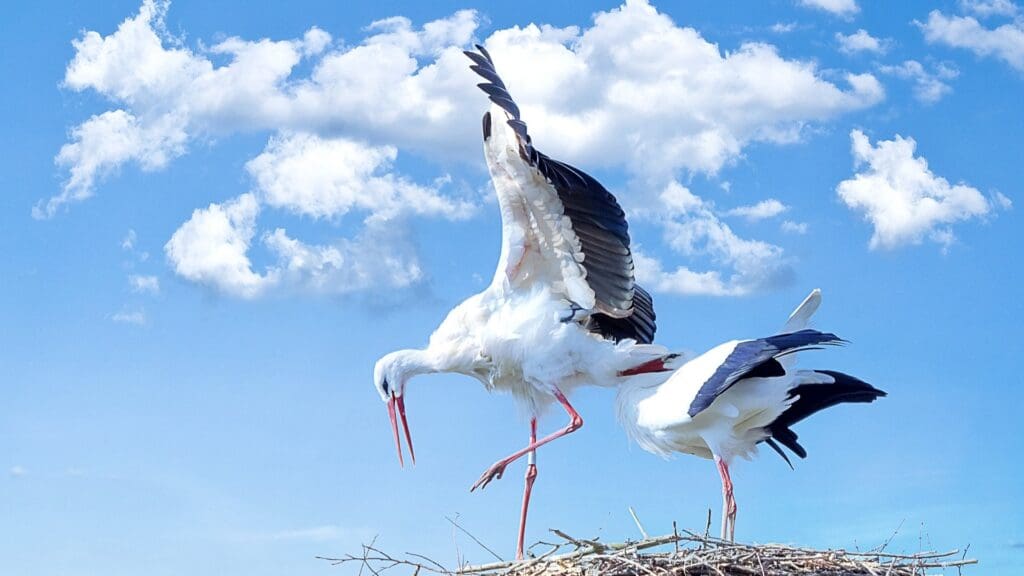Throughout history, the beginning of spring was thought of as a time of renewal, and for the people in Hungary and Central Europe, it was also a time to welcome back a series of beloved bird species—including storks. Every year, these graceful birds make a long and perilous journey from their wintering grounds in Africa back to their breeding grounds in Central Europe and Asia, and in the Hungarian culture, their return is a cause for celebration. Storks are a bird species that hold a special place in the hearts and minds of the people of Hungary. Historically, people in the region ascribed immense cultural significance to them. These elegant birds are known for their beauty, and loyalty, making them a beloved and revered symbol in the country.
One of the most significant cultural associations related to storks is that they herald fertility and childbirth—probably partially due to the aforementioned fact that the arrival of the birds and the spring regeneration of nature happen at the same time. In Europe, throughout history, storks have been associated with the arrival and delivery of babies and the celebration of new life in Hungary. While the exact source of this myth is not certain—although its popularisation is undoubtedly owed to Hans Christian Andersen and his tale entitled The Storks—curiously enough, some statistical data shows a correlation between stork populations and human birth rates.
The distinctive nests of storks, perched high up on rooftops and chimneys, have become a familiar sight to people in Central Europe, and they are often seen as a sign of good luck and prosperity. There is a belief that having a stork build a nest on the chimney of one’s house brings good fortune and happiness to the inhabitants.
Part of the cultural reverence of these birds might very well stem from the role storks play in maintaining ecological balance. In wetland ecosystems, storks are top predators, feeding on a variety of small animals such as frogs, snakes, and insects. By controlling the populations of these animals, storks help to maintain a healthy balance in the ecosystem, which makes them a vital part in maintaining biodiversity.
Storks also have a central part in Hungarian folklore. Like in many other European countries, the most well-known story that features a stork is The Stork and the Fox in Hungary, too. This tale was first recorded in the collection of Phaedrus in the 1st century AD, that is, it is one of Aesop’s fables. According to the tale, the fox invites the stork for lunch, but he serves soup in a bowl that the stork cannot enjoy. Then the stork returns the favour and offers the fox a meal in a narrow-necked vessel the fox cannot eat from. In a witty and easily accessible way, the story teaches children about being considerate, and to treat others the way we want them to treat us. This story is one of the first fables all Hungarian children learn at home. Else than this famous fable, storks appear in many other Hungarian folk stories as well, which pass on wisdom as well as the love of these birds even to the youngest of Hungarians.
Although some storks can occasionally stay in the country during milder winters, they are normally present in Hungary only for seven months, from March to September. The Hungarian Ornithological and Nature Conservation Society (MME) has reported that the majority of storks that nest in Hungary typically migrate to their traditional wintering grounds in central Africa, primarily in Chad and Sudan. However, some storks opt for an easterly route towards the Middle East and Israel, while others embark on a lengthy flight of up to 8000 kilometres, all the way to South Africa.
In the months when storks are nesting in Hungary, the well-being of these graceful creatures largely depends on the availability of shallow water grounds and farmland areas that offer food and vegetation. The Hortobágy National Park and the Tisza Lake, located approximately 100-150 kilometre east of Budapest, are ideal breeding grounds and resources for storks. For those interested in birdwatching, visiting these locations is a must. Other ideal stork-watching destinations include the Bugyi area in the Kiskunság National Park, situated at only 40 kilometres south of the capital. While these places are best for seeing storks in their natural habitat, their nests can be found anywhere in the country with the help of the Hungarian Ornithological and Nature Conservation Society’s online database.
Storks in Hungary have relatively few natural predators due to their large size and ability to build their nests in high places, such as the top of chimneys or electricity poles. However, there are some predators that can theoretically pose a threat to storks, mostly to young or weakened specimens. One of the main predators of storks in Hungary is the red fox, which can prey on chicks and fledglings, as well as steal accidentally lost eggs. Other predators that may target young or ill storks include birds of prey such as eagles and owls, as well as wild cats and martens. In addition to natural predators, storks in Hungary can also face threats from different parasitical organisms, such as lice and mites.

Although the cultural perception of storks is overwhelmingly positive across almost all cultures, human-related threats such as habitat loss, disturbance, and collisions with power lines can have a significant impact on stork populations, highlighting the importance of conservation efforts and habitat protection for these birds. Unfortunately, storks are extremely vulnerable during their migration, and some of them are shot illegally as hunting trophies. According to results presented by the Bird Conservation International, in total, 0.4–2.1 million birds, including storks, were estimated to be illegally killed in Northern and Central Europe and the Caucasus region in 2017. As a result, although white storks in Europe have relatively few natural predators, they still face a range of threats that require ongoing efforts to protect and conserve their populations.
Hungary, for one, does a lot to protect storks and other bird species. Aside from conservation efforts, the Hungarian Ornithological and Nature Conservation Society’s (MME) key initiatives involve combatting the use of poisonous baits and carcasses, which can have devastating effects on local animal and bird populations. To assist with this effort, MME employs two specially trained dogs able to detect and locate poisoned baits and carcasses. The success of these four-legged employees has led MME to help other organisations to adopt anti-poison dog units both within Hungary and abroad. In addition to its efforts to combat poisoning, MME also works to gather data on crimes against birds from citizens and other relevant stakeholders. This information is then compiled into a national database, which is used by a National Anti-Poisoning Working Group, comprised of national park directorates, NGOs, veterinarians, police, and hunters. By collaborating and sharing information, these groups are better equipped to address issues related to crimes against Hungarian wildlife. MME also advocates for stronger enforcement of nature laws, which is essential to combatting illegal killings in Hungary. Through its various initiatives and partnerships, MME is working tirelessly to protect Hungary’s precious natural resources and ensure a brighter future for the country’s wildlife populations.
Related articles:







